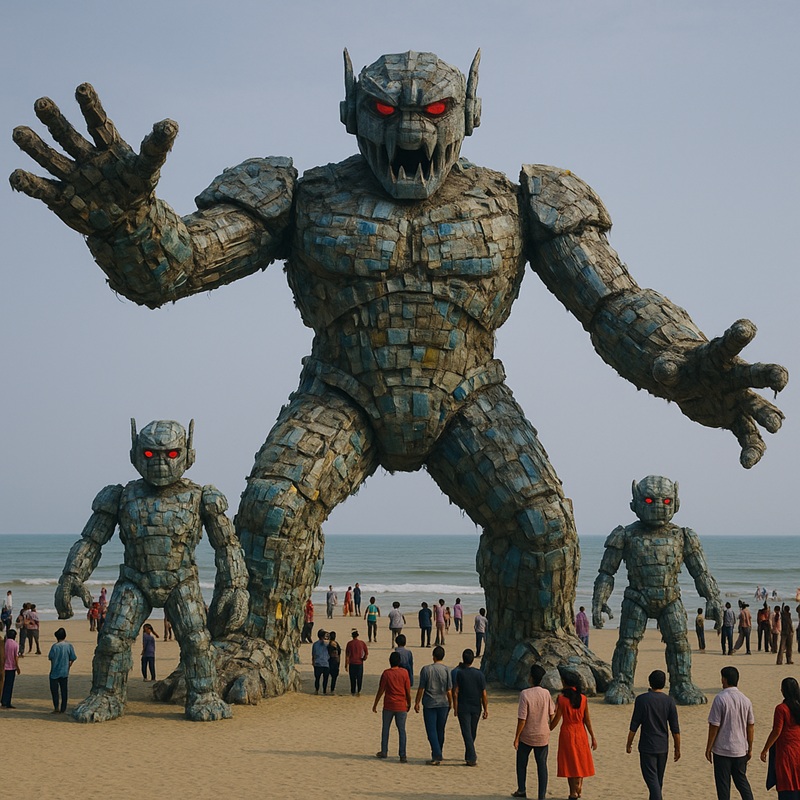On the world’s longest sea beach in Cox’s Bazar, Bangladesh, a towering 62-foot-tall plastic “robot monster” has captured global attention—not as a feat of sculpture, but as a symbol of the mounting crisis of marine pollution. Built from over 10 metric tons of discarded plastic, this enormous structure was unveiled in early June 2025 as a part of a bold environmental awareness campaign led by the Bidyanondo Foundation.
Crafted entirely from waste collected from Cox’s Bazar and Saint Martin’s Island, the robot—reminiscent of a Transformer from science fiction—stands as a visual metaphor for how humanity’s inventions and conveniences have turned into threats for the natural world. This is not just art—it’s a call to action.
A Monument of Waste
The monster’s limbs and body are built from abandoned bottles, packaging materials, fishing nets, and countless other plastic items that once floated in the Bay of Bengal. Alongside the giant, two smaller 15-foot “plastic children” stand, making the display a family of synthetic behemoths constructed from humanity’s throwaways.
Local residents participated in the campaign by collecting plastic waste in exchange for essential goods such as rice and household items, making the initiative both impactful and inclusive. Volunteers also helped sort and assemble the collected waste to create the structure, now one of the largest sculptures of its kind in the world.
Why Bangladesh?
Bangladesh is on the front lines of the climate and environmental crisis. Though it contributes relatively little to global greenhouse gas emissions, it bears the brunt of rising sea levels, plastic pollution, and biodiversity loss. With a population of nearly 170 million and limited solid waste infrastructure, the country generates around 800,000 tonnes of plastic waste annually. In the capital, Dhaka, alone, about 646 tonnes of plastic waste is produced every day.
Much of this plastic ends up in rivers and coastal areas, contributing to significant marine pollution. Only about 37% of plastic waste is recycled, while the rest either remains in landfills or escapes into the environment. The Buriganga River in Dhaka—once a lifeline for the city—is now among the most polluted water bodies due to unchecked plastic dumping.
Single-use plastics, particularly beverage bottles and food containers, make up a large share of this waste. Bangladeshis discard billions of such items every year, with little public awareness or formal recycling infrastructure to manage the fallout.
A Global Crisis
Marine pollution is not just a regional problem—it is a planetary emergency. According to the United Nations, more than 11 million tonnes of plastic enter the ocean each year, and without urgent action, this figure could triple by 2040. The oceans are now home to five major garbage patches, including the Indian Ocean Garbage Patch, which affects countries from East Africa to Southeast Asia.
Microplastics—tiny fragments from degraded plastic—have been found in everything from deep-sea fish to table salt and even human blood. This global issue threatens ecosystems, food safety, public health, and economies dependent on tourism and fisheries.
The World Bank and UN Environment Programme have repeatedly called for coordinated international responses to curb the crisis, from banning certain plastics to investing in circular economy models.
Solutions in Motion
Bangladesh, despite limited resources, has begun taking steps. In recent years, the government banned polythene bags and is now phasing out certain single-use plastics. NGOs and private organizations like the Bidyanondo Foundation are filling gaps in public awareness and action. The plastic robot monster is a prime example—striking, educational, and inspiring.
Innovative measures such as deploying floating trash barriers in rivers, converting waste into construction materials, and setting up recycling banks are slowly making an impact. Schools are also integrating environmental awareness campaigns to educate the next generation.
But plastic knows no borders. Waste dumped in one country can drift to another’s shores. Sea creatures entangled in trash off the coast of Bangladesh may have swallowed plastic manufactured in another continent. Hence, international collaboration is key.
A Warning to the World
The towering plastic robot monster on the beach of Cox’s Bazar is more than a local attraction—it’s a stark symbol of global failure to manage consumption and waste. It warns the world of the monster we’ve collectively created, and the future we’re racing toward if swift action is not taken.
Whether you're in New York, New Delhi, Nairobi, or Naples, the message is the same: reduce plastic use, support sustainable alternatives, hold industries accountable, and strengthen international efforts to clean up our oceans.
As global audiences gaze upon this imposing figure made from society’s castoffs, it serves as both a reflection and a wake-up call. We built the monster. Now, we must dismantle it—together.
